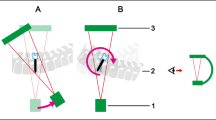Abstract
Purpose
This retrospective matched case–control study was conducted to compare two CT based surgery techniques for navigated screw placement in spinal surgery, whether a reduction of radiation exposure and surgery time could be achieved.
Methods
We matched cases treated with an intraoperative CT (iCT), regarding the type and number of implants, with cases treated with a preoperative CT (pCT) of one main surgeon. Outcome measures were radiation exposure due to intraoperative control x-rays, radiation exposure due to CT images, and the duration of surgery.
Results
The required radiation exposure could be significantly reduced in the iCT group. For the intraoperative control X-rays by 69% (median (MED) 88.50/standard deviation (SD) 107.84 and MED 286.00/SD 485.04 for iCT and pCT respectively—in Gycm2; p < 0.001) and for the CT examinations by 25% (MED 317.00/SD 158.62 and MED 424.50/SD 225.04 for iCT and pCT respectively—in mGycm; p < 0.001) with no significant change in surgery time. The correlation between the number of segments fused and the necessary surgery time decreased significantly for the iCT group (Pearson product-moment-correlation: r = 0.569 and r = 0.804 for iCT and pCT respectively; p < 0.05).
Conclusion
The results show that spinal navigation using an intraoperative CT with automatic registration compared to a preoperative CT and intraoperative manual surface registration, allows a significant reduction of radiation exposure, without prolonged surgery time. A significant benefit regarding cut-to-suture-time can be gained with surgeries of a larger scale.




Similar content being viewed by others
Availability of data and materials
All data used in this study are available.
References
Singer G (2005) Occupational radiation exposure to the surgeon. J Am Acad Orthop Surg 13(1):69–76. https://doi.org/10.5435/00124635-200501000-00009
Hadelsberg UP, Harel R (2016) Hazards of ionizing radiation and its impact on spine surgery. World Neurosurg 92:353–359. https://doi.org/10.1016/j.wneu.2016.05.025
Mastrangelo G, Fedeli U, Fadda E, Giovanazzi A, Scoizzato L, Saia B (2005) Increased cancer risk among surgeons in an orthopaedic hospital. Occup Med (Chic Ill) 55(6):498–500. https://doi.org/10.1093/occmed/kqi048
Blakely EA (2000) Biological effects of cosmic radiation: deterministic and stochastic. Health Phys 79(5):495–506. https://doi.org/10.1097/00004032-200011000-00006
Hecht N, Yassin H, Czabanka M, et al. (2018) Intraoperative computed tomography versus 3D C-arm imaging for navigated spinal instrumentation. Spine (Phila Pa 1976) 43(5):370–377. https://doi.org/10.1097/BRS.0000000000002173
Scarone P, Vincenzo G, Distefano D et al (2018) Use of the Airo mobile intraoperative CT system versus the O-arm for transpedicular screw fixation in the thoracic and lumbar spine: a retrospective cohort study of 263 patients. J Neurosurg Spine 29(4):397–406. https://doi.org/10.3171/2018.1.SPINE17927
Farah K, Coudert P, Graillon T et al (2018) Prospective comparative study in spine surgery between O-arm and airo systems: efficacy and radiation exposure. World Neurosurg 118:e175–e184. https://doi.org/10.1016/j.wneu.2018.06.148
Geerling J, Gösling T, Gösling A et al (2008) Navigated pedicle screw placement: experimental comparison between CT- and 3D fluoroscopy-based techniques. Comput Aided Surg 13(3):157–166. https://doi.org/10.3109/10929080802102110
Yoshihara H, Yoneoka D (2015) National trends in the surgical treatment for lumbar degenerative disc disease: United States, 2000 to 2009. Spine J 15(2):265–271. https://doi.org/10.1016/j.spinee.2014.09.026
Pannell WC, Savin DD, Scott TP, Wang JC, Daubs MD (2015) Trends in the surgical treatment of lumbar spine disease in the United States. Spine J 15(8):1719–1727. https://doi.org/10.1016/j.spinee.2013.10.014
Cohen J, Lachenbruch PA (1989) Statistic statistical power analysis for the behavioral sciences (2nd ed.). J Am Stat Assoc 84:408
Huda W, Nickoloff EL, Boone JM (2008) Overview of patient dosimetry in diagnostic radiology in the USA for the past 50 years. Med Phys 35(12):5713–5728. https://doi.org/10.1118/1.3013604
Wrixon AD (2008) New ICRP recommendations. J Radiol Prot 28(2):161–168. https://doi.org/10.1088/0952-4746/28/2/R02
Carl B, Bopp M, Pojskic M, Voellger B, Nimsky C (2019) Standard navigation versus intraoperative computed tomography navigation in upper cervical spine trauma. Int J Comput Assist Radiol Surg 14(1):169–182. https://doi.org/10.1007/s11548-018-1853-0
Author information
Authors and Affiliations
Corresponding author
Ethics declarations
Conflict of interest
Marcus Richter holds company shares of Intrinsic Therapeutics and held lectures or has consultancy contracts with Brainlab, DePuy/Synthes, Intrinsic Therapeutics, Silony, Stryker, and Ulrich Medical. Philip Hartung held lectures for Brainlab and Ulrich medical. For the remaining authors none were declared.
Ethics approval
All protocols for this retrospective study were approved on the 8th of October 2019 by the ethics committee of the state chamber of physicians in Hesse, Germany. (Number: 2019–1400-evBO).
Consent to participate/Consent for publication
All participants in this study were older than 18 years of age at the time of their participation. After being informed in detail, all participants declared their willingness to participate in this study, and consented to the publication of the results, both verbally and in writing.
Additional information
Publisher's Note
Springer Nature remains neutral with regard to jurisdictional claims in published maps and institutional affiliations.
Rights and permissions
About this article
Cite this article
Marzouk, M.M., Afghanyar, Y., Marzouk, M.M. et al. Comparison of radiation exposure and surgery time between an intraoperative CT with automatic surface registration and a preoperative CT with manual surface registration in navigated spinal surgeries. Eur Spine J 31, 685–692 (2022). https://doi.org/10.1007/s00586-021-07082-x
Received:
Revised:
Accepted:
Published:
Issue Date:
DOI: https://doi.org/10.1007/s00586-021-07082-x




